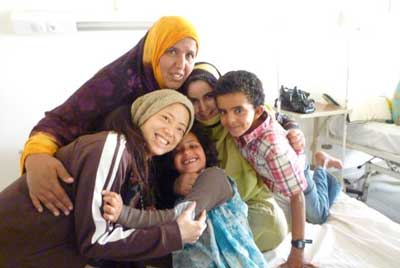 Ms. Yoko Atsumi is a 5th year medical student at Kagoshima University in Japan. She is a recipient of the 2010 JMSA-Nishioka Foundation scholarship, which supported her work with the Sahara Fund Medical Mission. Ms. Atsumi spent a month providing healthcare at refugee camps in Algeria. Please click “Read more” to read her progress report and view photographs from her mission.
Ms. Yoko Atsumi is a 5th year medical student at Kagoshima University in Japan. She is a recipient of the 2010 JMSA-Nishioka Foundation scholarship, which supported her work with the Sahara Fund Medical Mission. Ms. Atsumi spent a month providing healthcare at refugee camps in Algeria. Please click “Read more” to read her progress report and view photographs from her mission.
Sahara Fund Medical Mission
Date: Feb.27- Mar.27, 2010
Place:
1. A clinic at Tifariti (Western Sahara)
2. A clinic at Tindouf (Algeria)
Purpose:
1. To learn about the lives of those in refugee camps and Western Sahara
2. Medical volunteer work at the refugee camp clinics and Western Sahara
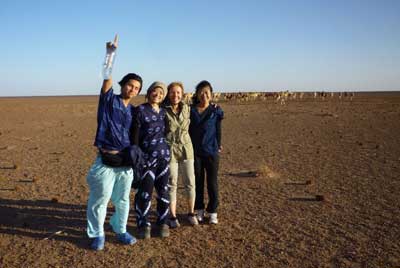 Background and history
Background and history
Western Sahara is a disputed territory in North Africa, bordered by Morocco to the north, Algeria to the northeast, Mauritania to the east and south, and the Atlantic Ocean to the west. Its surface area amounts to 266,000?square kilometres (103,000 sq?mi). It is one of the most sparsely populated territories in the world, mainly consisting of desert. The population is estimated at just over 500,000.
Large areas of Western Sahara have been occupied and claimed by Morocco, but most other countries do not recognize this territory as belonging to Morocco.
When Morocco invaded Western Sahara, many people were forced to evade to the neighboring Algeria. This is how refugee camps developed in Algeria.
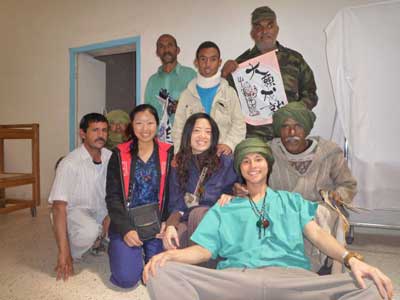
Local life in refugee camps
– In Tindouf, there are four main refugee camps and each has a governor.
– Almost all people are Muslim and pray at the specific times during the day.
– The refugee camps have been in existence for more than 35 years and their lives depend on donations of food, articles for daily use and so on, from the United Nations and other countries. The refugees therefore do not suffer from hunger.
– Although the land is largely a desert, there is ample underground water.
– Some people own camels and goats, and they eat them during special celebrations.
– Industrial and educational systems have not been developed enough yet at the camps.

– There are almost no resources in Western Sahara, and the people rely on imported and donated resources from other countries.
Medical volunteer work
– There is an astounding shortage of physicians in the area
– Almost all physicians who worked there were the volunteers from other countries, mostly from Europe.
– In Tifariti, it was hard to get the support of the volunteers because of its location (in the middle of the desert).
– The nurses were a valuable asset, and they were doing the best possible, however, their medical knowledge was limited and there were occasional errors in selecting treatments or medications for patients.
W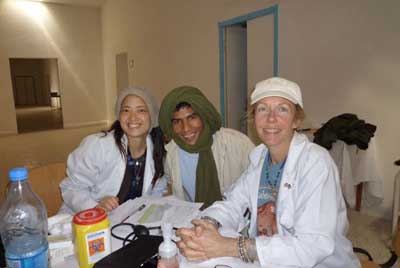 hat we did as medical volunteers
hat we did as medical volunteers
We consulted the patients in each clinic every day (Tindouf and Tifariti) and provided treatment for the patients as needed.
About the common diseases in Western Sahara and refugee camps
In contrast to what I was expecting, no patients were suffering from malnutrition due to starvation. The three most common problems were actually obesity, high blood pressure, and diabetes mellitus.
The reasons:
– Fewer opportunities to exercise because of harsh desert environment.
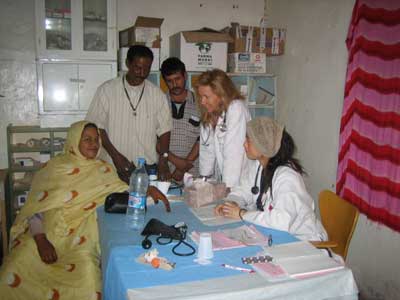 – There is a tradition to drink tea with much sugar. (It used to be a ceremony, but it has become a daily habit now)
– There is a tradition to drink tea with much sugar. (It used to be a ceremony, but it has become a daily habit now)
– Lack of education about health maintenance
Our advise to the patients with those conditions
(Obesity, diabetes and hypertension)
– Avoid eating too much oily food
– Drink much water (3 bottles of water daily)
– Avoid taking too much salt
– Walk as much as possible
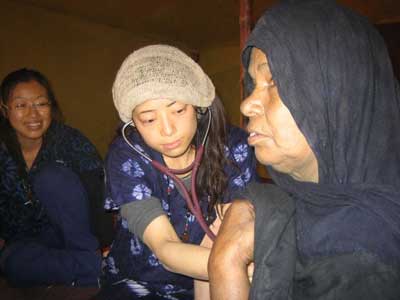 Since there were not enough doctors and clinics, to control those problems with medication was not ideal.
Since there were not enough doctors and clinics, to control those problems with medication was not ideal.
The most important and effective thing was to change their life styles.
Other common conditions
Constipation: because of dry lands and not drinking enough water
GERD: because people tend to eat late (10 to 11 pm) right before going to bed. It seems to be a part of their tradition.
What I felt and thought during the mission
I asked myself this question many times while I was there. It was; ‘What is the best support for the developing countries?” In spite of my guess before visiting the refugee camps, the people there were not suffering from the hunger. To my surprise, the three most common problems in camps were obesity, high blood pressure, and diabetes. They were provided enough food and daily supply by the UN and other countries. However, ironically, those foods were mainly oil and carbohydrate (rice and bread). Also, because of the harsh environment, people tend to avoid going outside and stay inside of their tents. Therefore, because of oily food and lack of exercise lead people to obese and disease such as diabetes and hypertension.
There was another problem. Because of the easy access to the food and other supplies, there is no need to work for the people in refugee camps. Therefore, they seemed to have lost the motivation to work, and many people stayed home and drink tea all day long. However, we shouldn’t blame them for the situation. I think this situation has been caused by the developed country that have provided donations for more then 35 years without thinking critically about what the people really need. As a result of being dependent for the supply from other countries, the people lost the specialized skill such as sailing and fishing, and new generations lost their opportunity and motivation for the education and work. It is very difficult now to be independent from the support of UN and other countries.
As I visited and learn the situation at the refugee camps, I felt that the ongoing support by the UN and other countries are not ideal way of support. When we try to support someone, we really have to think about what they really need, instead of just provide money or supplies. To do so, it’s very important to know about their background and situation, the future outcome of the support, and the endpoint of the support (goal). We have to see the situation from the local people’s point of view and find the best way for their future.
The overall experience was really valuable and I gained lots of knowledge. It’s not only medical knowledge and skill, but also about problem in the international corporation.I’d like to thank for JMSA for supporting my mission. It was impossible to complete the mission without JMSA’s help. I would love to participate and get involved in the future program at JMSA as much as possible. Thank you again for the support.
アルジェリア・西サハラでの医療ボランティア報告書
研修場所はアルジェリア内の難民キャンプおよび西サハラ内の診療所で、現地での滞在期間は4週間でした。研修内容としては、テレサ医師が以前から関わっていたTifariti診療所での医療の補佐、地域の人々との関わり(相互文化交流)、アルジェリアでのBue-la病院および難民キャンプでの診療補佐などでした。
私が今まで訪れたことのあるサハラ以南のアフリカ諸国では、HIVや貧困、栄養不足が大きな問題でしたが、それらの国とは大きく異なり、援助が行き届いている難民キャンプでの35年以上に渡る生活という特殊な状況での問題がとても印象的でした。私が想像していたHIVや栄養不足などの健康問題ではなく、診療所に訪れるアルジェリアでの難民キャンプや西サハラの砂漠内に住む人々の主な健康問題は、糖尿病や高血圧が多く、次いで頭痛や腰痛など、そして消化不良などの胃腸障害が多かったのが驚きでした。また、肥満の人も多かったです。その原因としては、難民キャンプ内では、UNを始めとする海外のボランティア団体からの援助物資が豊富に供給されていることにより、働かなくても人々が無料で食べ物を手に入れることが可能であり、砂漠という特殊な環境では、移動も車に頼ることがほとんどで体を動かす機会がほとんどないということが大きな原因だと考えられます。また、ボランティア医師団による定期的な医療活動も行われてはいますが、常駐している西サハラ人の医師数が絶対的に少なく(テレサ医師によると4~5人だということです)、また西サハラ人の薬剤師、看護師、PTやOT、他の医療技師などの数も足りていないため、知識の乏しい人による薬剤の乱用も深刻な問題となっています。例を挙げると、腰痛で病院を訪れた人が、医師不足のために医師以外の人からペニシリン(抗生物質)の注射を受けていたり、患者さんへの説明不足が原因で、患者さんが間違った分量の薬を服用していたり、あるいは全く服用していなかったりということが日常茶飯事のようでした。また、病院に常駐しているスタッフでも、実際に医療トレーニングを積んでいる人は少なく、病院に入院していても血圧すら測ってもらえないということも多いようでした。さらに、X線技師がいてもX線の機械が壊れたままで放置されているため、技術はあるのに仕事がないなど、医療器材の不足も、医療活動を困難にしている原因のひとつとなっていました。
私が西サハラおよびアルジェリアの難民キャンプに一ヶ月滞在して感じたことは、海外からの国際協力のあり方や、これからの援助の形などは、一概に「これが正しい」と言える答えはなく、さまざまなことを考え、現地の人々を理解し、彼らと連携、協力しながら試行錯誤していくことでしか解決はできないと思いました。
最後になりましたが、この医療ボランティアへの参加を可能にしていただいたJMSAの方々からのご支援に心から感謝しています。現在は帰国し、鹿児島大学でのポリクリ実習を再開しておりますが、今後も可能な限り、積極的にJMSAの活動のお手伝いをさせていただきたいと思っています。本当にありがとうございました。
鹿児島大学医学部5年
平野陽子

